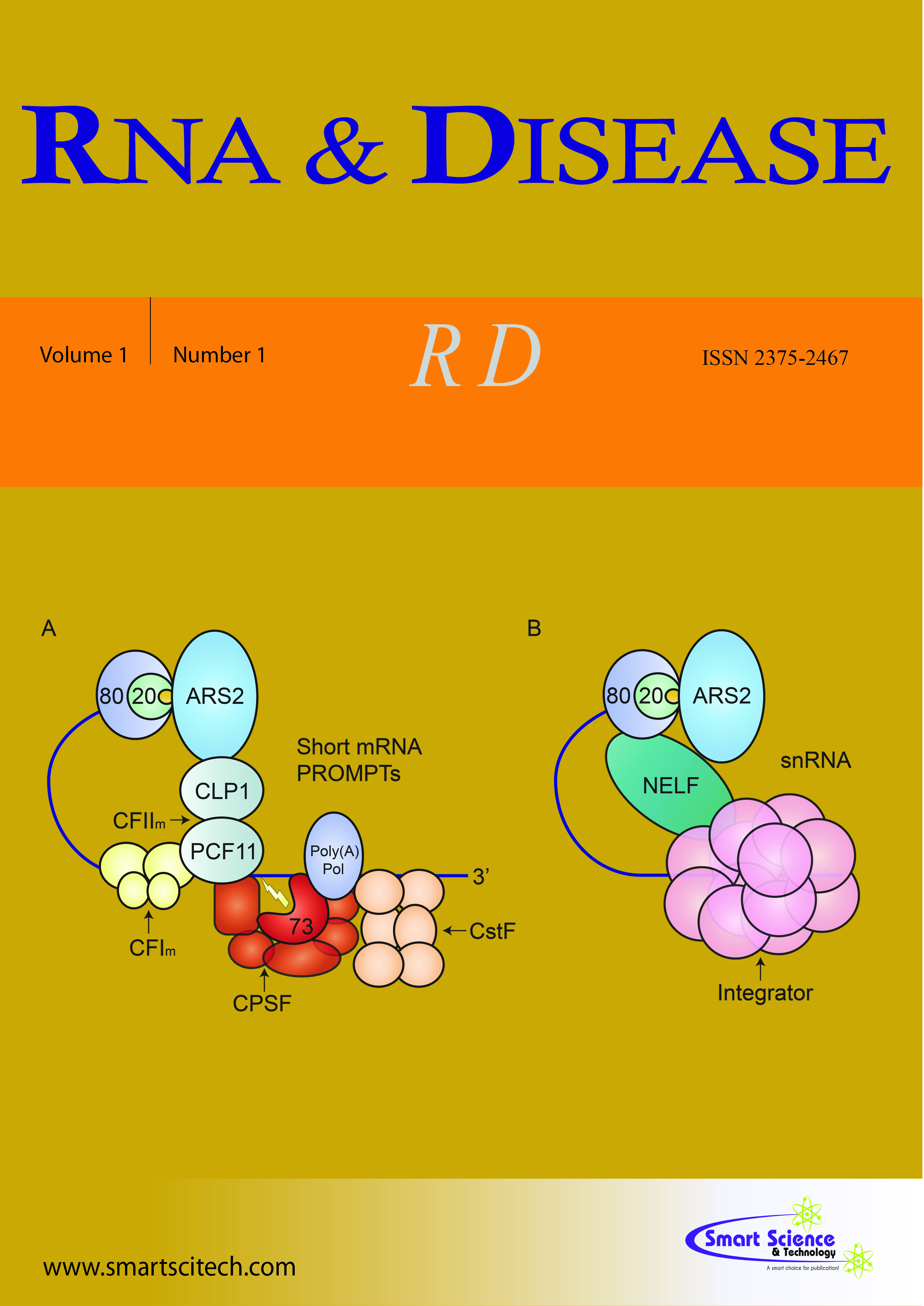Non-coding RNA in breast cancer
DOI: 10.14800/rd.453
Abstract
With the availability of next-generation sequencing technologies since the early 2000s, non-coding RNAs have been assessed as potential therapeutic targets for numerous diseases. It is well documented that non-coding RNAs (ncRNAs), including circular RNA (circRNA), small nuclear RNA (snRNA), small nucleolar RNA (snoRNA), PIWI-interacting RNAs (piRNA), microRNAs (miRNAs), and long non-coding RNAs (lncRNAs), play critical roles in cellular physiology and disease pathogenesis [1].
Since the discovery of ncRNAs, their roles have gained great attention and their biological function have been extensively studied. snRNAs and snoRNAs have been found to participate in mRNA splicing and rRNA maturation respectively [2,3]. circRNAs can act as competing endogenous RNA (ceRNA) for microRNAs, thus reducing miRNA repression of their target mRNAs [4]. Moreover, circRNAs also modulate the stability of mRNAs, interact with RNA binding proteins, and regulate gene transcription by interacting with RNA pol II [5]. piRNAs were reported to work in PIWI–piRNA complexes to regulate gene expression at the epigenetic and post-transcriptional levels [6]. As of today, miRNAs and lncRNAs were the two most widely studied ncRNAs. They have been found to be involved in the regulation of breast cancer cell proliferation, apoptosis, angiogenesis, epithelial to mesenchymal transition (EMT), cancer stem cells (CSCs) phenotype, interplay of tumor microenvironment, and drug resistance [7].
Breast cancer is the most common malignancy, and is the second cause of cancer death among females worldwide, accounting for an estimated 266,120 new cases and 40,920 deaths in 2018 [8]. Various miRNAs and lncRNAs have been established as potential biomarkers for diagnosis and prognosis in breast cancer [9, 10]. Kawaguchi et al. developed a novel three-miRNAs risk score (i.e., miR-19a, miR-93, and miR-106a) using the TCGA cohort to predict prognosis of survival and bone recurrence in breast cancer patients [11]. Meng et al. found that lncRNAs U79277, AK024118, BC040204, and AK000974 might contribute to the selection of high-risk patients for adjuvant therapy, which is independent of age and breast cancer subtypes [12].
The potential of ncRNAs as therapeutic targets has also been explored extensively in breast cancer. The main advantage of ncRNA based therapeutics is that it can target multiple coding or non-coding genes that regulate specific or redundant pathways involved in cancer development. However, therapeutics based on ncRNAs encounter some obstacles, such as problems associated with the delivery, potential off-target effects, and safety. Various studies have implied that emerging gene editing technology such as CRISPR/Cas9 (Clustered Regularly Interspaced Short Palindromic Repeats [CRISPR]-associated nuclease-9) system in ncRNA editing could not only correct cancer-causing mutations but also has the potential to edit the ncRNA genes in addition to protein-coding genes [13-15]. For example, Ho et al. successfully generated knockouts for miR-21, miR-29a, lncRNA-21A, UCA1 and AK023948 using CRISPR/Cas system through an HR-based selection and/or dual gRNA approach [16].
Excitingly, several miRNA-based therapeutics are underway by various pharmaceutical companies and part of them are in pre-clinical and clinical stages. More than ten clinical trials about miRNA-based therapeutics, including anti-miR-122, anti-miR-103/107, anti-miR-155, miR-29 mimic, miR-16 mimic, and miR-34 mimic, have been registered in the website ClinicalTrials (http://clinicaltrials. gov/ct2/home) [17]. One of the first miRNA?based molecules to enter clinical development was the locked nucleic acid (LNA) miravirsen, antisense RNA oligo of miR?122, for the treatment of hepatitis C virus (HCV).
Miravirsen resulted in a dose-dependent reduction in HCV RNA levels and no dose-limiting adverse events and no escape mutations were observed in the miR-122 binding sites of the HCV genome [18]. The success of the phase 2a trial has led to the advancement of miravirsen into additional phase 2 trial with more patients, long-term follow-ups, and multidrug combinations (clinicaltrials. gov/ct2/show/NCT01872936). Therefore, we believe more such plans for clinical trials for breast cancer might be under conception and breakthrough can be expected in the near future.












